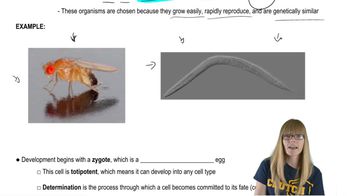Explain differences between whole-genome sequencing (WGS) and whole-exome sequencing (WES), and describe advantages and disadvantages of each approach for identifying disease-causing mutations in a genome. Which approach was used for the Human Genome Project?
Table of contents
- 1. Introduction to Genetics51m
- 2. Mendel's Laws of Inheritance3h 37m
- 3. Extensions to Mendelian Inheritance2h 41m
- 4. Genetic Mapping and Linkage2h 28m
- 5. Genetics of Bacteria and Viruses1h 21m
- 6. Chromosomal Variation1h 48m
- 7. DNA and Chromosome Structure56m
- 8. DNA Replication1h 10m
- 9. Mitosis and Meiosis1h 34m
- 10. Transcription1h 0m
- 11. Translation58m
- 12. Gene Regulation in Prokaryotes1h 19m
- 13. Gene Regulation in Eukaryotes44m
- 14. Genetic Control of Development44m
- 15. Genomes and Genomics1h 50m
- 16. Transposable Elements47m
- 17. Mutation, Repair, and Recombination1h 6m
- 18. Molecular Genetic Tools19m
- 19. Cancer Genetics29m
- 20. Quantitative Genetics1h 26m
- 21. Population Genetics50m
- 22. Evolutionary Genetics29m
15. Genomes and Genomics
Genomics and Human Medicine
Problem 21b
Textbook Question
Applied to the study of the human genome, a goal of GWAS is to locate chromosome regions that are likely to contain genes influencing the risk of disease. Specific genes can be identified in these regions, and particular mutant alleles that increase disease risk can be sequenced. To date, the identification of alleles that increase disease risk has occasionally led to a new therapeutic strategy, but more often the identification of disease alleles is the only outcome.
What is the value of being able to identify alleles that increase disease risk for a person who is currently free of the disease but who is at risk of developing the disease due to its presence in the family?
 Verified step by step guidance
Verified step by step guidance1
Understand the purpose of GWAS (Genome-Wide Association Studies): GWAS aims to identify genetic variants associated with specific diseases by analyzing the genomes of many individuals. This helps locate regions on chromosomes that may contain genes influencing disease risk.
Recognize the importance of identifying alleles that increase disease risk: Knowing which alleles are associated with a higher risk of disease can provide valuable information for individuals who are currently disease-free but have a family history of the disease.
Explain how this information can be used for preventive measures: If a person knows they carry a high-risk allele, they can take proactive steps such as lifestyle changes, regular medical screenings, or early interventions to reduce the likelihood of developing the disease.
Discuss the potential for personalized medicine: Identifying risk alleles allows for tailored medical advice and treatments based on an individual's genetic profile, improving the effectiveness of healthcare strategies.
Highlight the role of genetic counseling: For individuals at risk, genetic counseling can provide guidance on understanding their genetic predisposition, the implications for their health, and the options available to manage or mitigate the risk.
 Verified video answer for a similar problem:
Verified video answer for a similar problem:This video solution was recommended by our tutors as helpful for the problem above
Video duration:
1mPlay a video:
Was this helpful?
Key Concepts
Here are the essential concepts you must grasp in order to answer the question correctly.
Genome-Wide Association Studies (GWAS)
GWAS are research methods used to identify genetic variants associated with specific diseases by scanning the genomes of many individuals. This approach helps locate chromosome regions that may harbor genes influencing disease risk, allowing researchers to correlate genetic variations with health outcomes. By identifying these associations, GWAS can provide insights into the genetic basis of diseases and potential therapeutic targets.
Recommended video:
Guided course

Genetics of Development
Alleles and Genetic Risk
Alleles are different versions of a gene that can exist at a specific locus on a chromosome. Some alleles may be associated with an increased risk of developing certain diseases, particularly in individuals with a family history of those conditions. Understanding which alleles are linked to disease risk can help in assessing an individual's likelihood of developing the disease, even if they are currently healthy.
Recommended video:
Guided course

New Alleles and Migration
Preventive Healthcare and Risk Assessment
Identifying alleles that increase disease risk is valuable for preventive healthcare, as it allows for early intervention strategies. Individuals at risk can be monitored more closely, adopt lifestyle changes, or undergo regular screenings to catch potential health issues early. This proactive approach can lead to better health outcomes and may reduce the overall burden of disease in at-risk populations.
Recommended video:
Guided course

RNA Interference

 6:51m
6:51mWatch next
Master Human Genome Composition with a bite sized video explanation from Kylia
Start learningRelated Videos
Related Practice
Textbook Question
548
views
